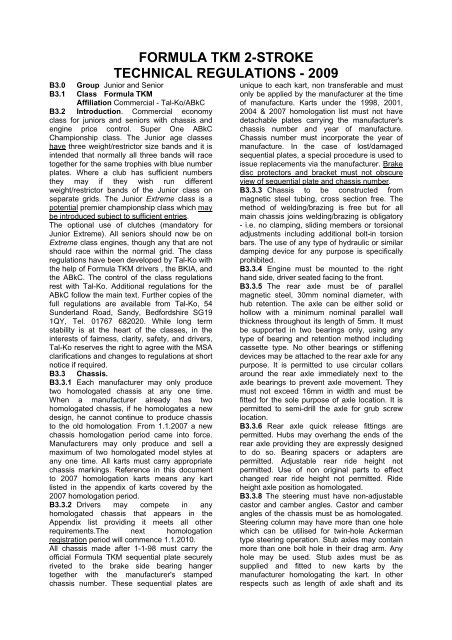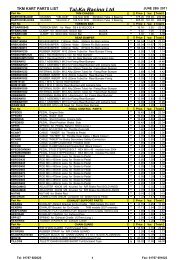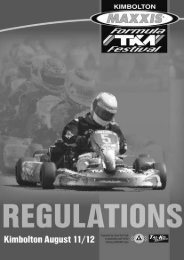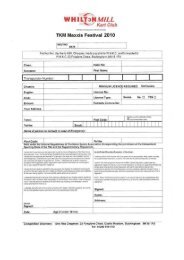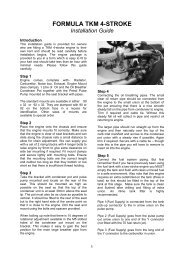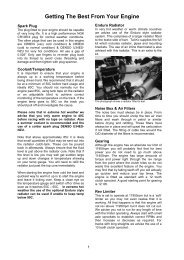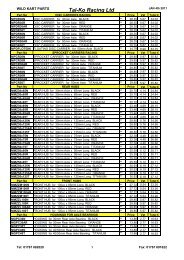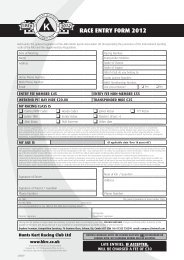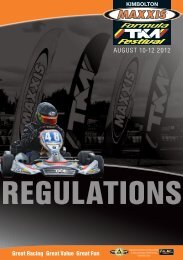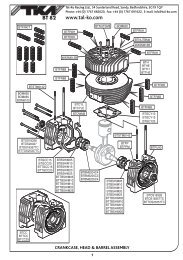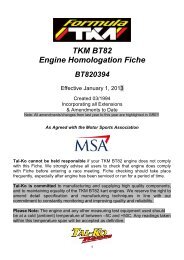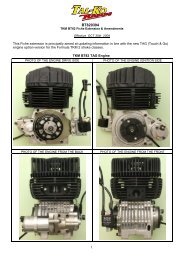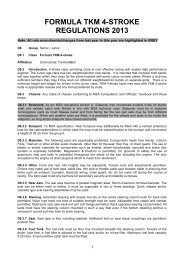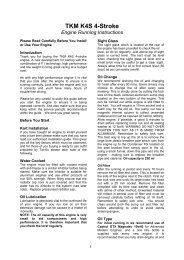formula tkm 2-stroke technical regulations - 2009 - Tal-Ko
formula tkm 2-stroke technical regulations - 2009 - Tal-Ko
formula tkm 2-stroke technical regulations - 2009 - Tal-Ko
You also want an ePaper? Increase the reach of your titles
YUMPU automatically turns print PDFs into web optimized ePapers that Google loves.
FORMULA TKM 2-STROKE<br />
TECHNICAL REGULATIONS - <strong>2009</strong><br />
B3.0 Group Junior and Senior<br />
B3.1 Class Formula TKM<br />
Affiliation Commercial - <strong>Tal</strong>-<strong>Ko</strong>/ABkC<br />
B3.2 Introduction. Commercial economy<br />
class for juniors and seniors with chassis and<br />
engine price control. Super One ABkC<br />
Championship class. The Junior age classes<br />
have three weight/restrictor size bands and it is<br />
intended that normally all three bands will race<br />
together for the same trophies with blue number<br />
plates. Where a club has sufficient numbers<br />
they may if they wish run different<br />
weight/restrictor bands of the Junior class on<br />
separate grids. The Junior Extreme class is a<br />
potential premier championship class which may<br />
be introduced subject to sufficient entries.<br />
The optional use of clutches (mandatory for<br />
Junior Extreme). All seniors should now be on<br />
Extreme class engines, though any that are not<br />
should race within the normal grid. The class<br />
<strong>regulations</strong> have been developed by <strong>Tal</strong>-<strong>Ko</strong> with<br />
the help of Formula TKM drivers , the BKIA, and<br />
the ABkC. The control of the class <strong>regulations</strong><br />
rest with <strong>Tal</strong>-<strong>Ko</strong>. Additional <strong>regulations</strong> for the<br />
ABkC follow the main text. Further copies of the<br />
full <strong>regulations</strong> are available from <strong>Tal</strong>-<strong>Ko</strong>, 54<br />
Sunderland Road, Sandy, Bedfordshire SG19<br />
1QY, Tel. 01767 682020. While long term<br />
stability is at the heart of the classes, in the<br />
interests of fairness, clarity, safety, and drivers,<br />
<strong>Tal</strong>-<strong>Ko</strong> reserves the right to agree with the MSA<br />
clarifications and changes to <strong>regulations</strong> at short<br />
notice if required.<br />
B3.3 Chassis.<br />
B3.3.1 Each manufacturer may only produce<br />
two homologated chassis at any one time.<br />
When a manufacturer already has two<br />
homologated chassis, if he homologates a new<br />
design, he cannot continue to produce chassis<br />
to the old homologation. From 1.1.2007 a new<br />
chassis homologation period came into force.<br />
Manufacturers may only produce and sell a<br />
maximum of two homologated model styles at<br />
any one time. All karts must carry appropriate<br />
chassis markings. Reference in this document<br />
to 2007 homologation karts means any kart<br />
listed in the appendix of karts covered by the<br />
2007 homologation period.<br />
B3.3.2 Drivers may compete in any<br />
homologated chassis that appears in the<br />
Appendix list providing it meets all other<br />
requirements.The next homologation<br />
registration period will commence 1.1.2010.<br />
All chassis made after 1-1-98 must carry the<br />
official Formula TKM sequential plate securely<br />
riveted to the brake side bearing hanger<br />
together with the manufacturer's stamped<br />
chassis number. These sequential plates are<br />
unique to each kart, non transferable and must<br />
only be applied by the manufacturer at the time<br />
of manufacture. Karts under the 1998, 2001,<br />
2004 & 2007 homologation list must not have<br />
detachable plates carrying the manufacturer's<br />
chassis number and year of manufacture.<br />
Chassis number must incorporate the year of<br />
manufacture. In the case of lost/damaged<br />
sequential plates, a special procedure is used to<br />
issue replacements via the manufacturer. Brake<br />
disc protectors and bracket must not obscure<br />
view of sequential plate and chassis number.<br />
B3.3.3 Chassis to be constructed from<br />
magnetic steel tubing, cross section free. The<br />
method of welding/brazing is free but for all<br />
main chassis joins welding/brazing is obligatory<br />
- i.e. no clamping, sliding members or torsional<br />
adjustments including additional bolt-in torsion<br />
bars. The use of any type of hydraulic or similar<br />
damping device for any purpose is specifically<br />
prohibited.<br />
B3.3.4 Engine must be mounted to the right<br />
hand side, driver seated facing to the front.<br />
B3.3.5 The rear axle must be of parallel<br />
magnetic steel, 30mm nominal diameter, with<br />
hub retention. The axle can be either solid or<br />
hollow with a minimum nominal parallel wall<br />
thickness throughout its length of 5mm. It must<br />
be supported in two bearings only, using any<br />
type of bearing and retention method including<br />
cassette type. No other bearings or stiffening<br />
devices may be attached to the rear axle for any<br />
purpose. It is permitted to use circular collars<br />
around the rear axle immediately next to the<br />
axle bearings to prevent axle movement. They<br />
must not exceed 16mm in width and must be<br />
fitted for the sole purpose of axle location. It is<br />
permitted to semi-drill the axle for grub screw<br />
location.<br />
B3.3.6 Rear axle quick release fittings are<br />
permitted. Hubs may overhang the ends of the<br />
rear axle providing they are expressly designed<br />
to do so. Bearing spacers or adapters are<br />
permitted. Adjustable rear ride height not<br />
permitted. Use of non original parts to effect<br />
changed rear ride height not permitted. Ride<br />
height axle position as homologated.<br />
B3.3.8 The steering must have non-adjustable<br />
castor and camber angles. Castor and camber<br />
angles of the chassis must be as homologated.<br />
Steering column may have more than one hole<br />
which can be utilised for twin-hole Ackerman<br />
type steering operation. Stub axles may contain<br />
more than one bolt hole in their drag arm. Any<br />
hole may be used. Stub axles must be as<br />
supplied and fitted to new karts by the<br />
manufacturer homologating the kart. In other<br />
respects such as length of axle shaft and its
angle, and the drag arm length and attachment<br />
holes, the stub is free.The king pin bolts must be<br />
centrally positioned in both the frame stub axle<br />
mounts and stub axles. The position of the holes<br />
must be non adjustable and permanently<br />
mounted. Detachable hole inserts not permitted.<br />
B3.3.9 Front ride height adjustment is<br />
permitted by movement of washers/spacers<br />
between the frame stub axle mounts and stub<br />
axle. On 1998, 2001, 2004 & 2007 homologated<br />
chassis the maximum permitted adjustment by<br />
this method is 12mm. No modifications may be<br />
carried out to the homologated design to<br />
achieve or increase this.<br />
B3.3.10 All karts must have the steering<br />
column mounted in such a way that even if the<br />
bottom retaining bolt is removed it cannot pull<br />
free from its lower bearing.<br />
B3.3.11 The only additions permitted to<br />
homologated chassis are: Equipment to meet<br />
latest MSA safety <strong>regulations</strong>. The following<br />
must not be added: Rear, front or side torsion<br />
bars, or any parts not homologated other than<br />
the exceptions indicated in these <strong>regulations</strong>.<br />
B3.3.12 The following parts are specifically<br />
prohibited: Components made from Kevlar,<br />
Carbon Fibre, Titanium or other similar exotic<br />
materials, other than for the seat and floor tray<br />
which is optional. Magnesium front and rear<br />
wheel hubs, engine mount, brake disc hub,<br />
sprocket carrier and steering wheel mounting<br />
boss may be used. The use of plastic or similar<br />
materials for components such as wheels,<br />
wheel hubs/bosses, sprocket and brake disc<br />
carriers is expressly forbidden.<br />
B3.3.13 Additional bolt on seat stays/mountings<br />
are permitted position and style free.<br />
B3.3.14 Use of CIK homologated crash tested<br />
bodywork consisting sidepods, a front fairing<br />
and Nassau panel is mandatory and must<br />
conform to MSA <strong>technical</strong> <strong>regulations</strong>. A CIK<br />
rear protection system is not permitted. The<br />
sidepods should be a matching pair of same<br />
homologation on either side and the front fairing<br />
and Nassau should also be a pair from the<br />
same homologation, but these two sets of body<br />
pairs can be from different homologations. It is<br />
permitted to modify the bodywork mounting<br />
points on the chassis to accept CIK crash tested<br />
bodywork but it must be undertaken in a<br />
professional manner. Karts homologated for the<br />
period up to 2006 where they are fitted with a<br />
traditional front bumper incorporating two<br />
vertical front uprights are permitted to make use<br />
of the CIK front fairings without the CIK<br />
associated metalwork. In this case, as long as<br />
the two vertical uprights remain in place, the<br />
requirement for an aluminium or steel securing<br />
block as per MSA rule 14.13.2 is waived and the<br />
fairing may be attached to the kart by any safe<br />
and secure method in two places, not<br />
necessarily the CIK type clips.<br />
TKM homologated karts for the period up to<br />
2006 inclusive with old style diagonal bar fixing<br />
points may use side bumpers with a minimum of<br />
one to be with a minimum size of 18mm<br />
diameter (19/20mm recommended) and a wall<br />
thickness of 1.4mm minimum securely fixed to<br />
the chassis by a minimum of two points on each<br />
side and must allow for the attachment of<br />
mandatory side bodywork. The plastic elements<br />
of the bodywork must be CIK crash tested and<br />
homologated as per MSA <strong>regulations</strong> but the<br />
sidepods must be of the fully enclosed type with<br />
closed ends. Sidepods may incorporate suitable<br />
holes for starter shaft, airbox trumpet, etc where<br />
MSA rules permit. When wet weather tyres are<br />
fitted, it is permitted for the wheels and tyres to<br />
be inside the sidepods, so long as the sidepods<br />
have closed solid ends.<br />
B3.3.15 Front & rear bumpers must comply to<br />
MSA Technical Regulations. Neither may<br />
incorporate adjustable torsion by design. Bolt in<br />
type torsion bars are specifically prohibited.<br />
Front bumper must not use rubber, nylon or<br />
similar material in its fastenings/mountings.<br />
Rear bumper may use rubber, nylon or similar<br />
material for a maximum of two of its<br />
fastenings/mountings to the frame but may be<br />
secured by more than these two fixings and may<br />
for example have bracing struts to the axle<br />
housing providing these were part of the original<br />
homologation.<br />
B3.3.16 Drivers may make use of tank tape,<br />
cable ties, thin wire or throttle cable type<br />
bowden cable in ensuring that items such as<br />
exhaust, bumpers, electrical wiring, chain guard,<br />
etc. do not come off during the course of racing.<br />
One or more fixings may be used, however the<br />
item used must only be there for secondary<br />
security and reliability purposes and must not be<br />
attached in such a manner that it affects<br />
torsional adjustment of the kart or provides any<br />
other performance advantage.<br />
B3.3.17 Seat type is free including material.<br />
Use of commercially available and<br />
manufactured variable rigidity adjustment<br />
systems for seats is permitted subject to the<br />
following criteria. The device must be mounted<br />
to the seat itself and must not be attached or<br />
have contact with the seat mounting points or<br />
chassis. It is not permitted to use ‘home<br />
constructed’ non-commercially available<br />
torsional adjustments.<br />
B3.3.18 Floor tray shape and material free but<br />
must comply to MSA Technical Regulations.<br />
Aluminium, plastic or other composite type floor<br />
trays may be used providing they provide<br />
suitable protection. Rubber mountings may be<br />
used. It is permitted to drill additional holes for<br />
the specific purpose of mounting such items as
pedal heel stops and fuel tank, and access hole<br />
for steering column lower location nut, provided<br />
that the holes are restricted to the minimum size<br />
and number required to meet the purpose. They<br />
must not cause undue weakening of the floortray<br />
at critical points. It is permissible to use<br />
suitable size metal, rubber or other washers in<br />
the fitment of the above items. It is permitted to<br />
use floor trays with decorative holes or slots so<br />
long as they are provided by the manufacturer<br />
and that the holes etc are in the raised sector(s)<br />
of the tray.<br />
B3.3.19 The fuel tank must be floor tray<br />
mounted beneath the steering column, forward<br />
of the driver. Type free. Fuel filter permitted<br />
either in-line or within the fuel tank or both.<br />
Maximum fuel tank capacity 9.25 litres. A catchtank<br />
must be used.<br />
B3.3.20 At all times the following must be<br />
original equipment parts as supplied by the<br />
manufacturer of the chassis:- Chassis frame,<br />
rear bumper, stub axles, pedals, steering<br />
column. They may not be replaced with bandit,<br />
non-standard, equivalents. These parts must<br />
always remain as supplied or homologated.<br />
B3.3.21 The insertion of an internal chassis<br />
strengthening steel tube, maximum length<br />
320mm, to prevent or repair cracking of the<br />
main side rail tubes is permitted to a maximum<br />
of one per side rail. This internal tube must be<br />
positioned at the rear of the kart encompassing<br />
at least 40% of the rear axle bearing hanger<br />
area.<br />
B3.3.22 On the grounds of safety the use of<br />
aluminium nuts and bolts is prohibited<br />
throughout the whole of the kart including the<br />
engine.<br />
B3.3.23 In the interests of safety and driver<br />
comfort, particularly for junior drivers, it is<br />
permitted to use a brake/throttle pedal/mount<br />
which has been amended to that originally<br />
homologated with the kart subject to the<br />
following criteria. The pedals must follow the<br />
original basic design but may have different<br />
diameter tubing, vary in height and have revised<br />
lugs for connections/stops. It must be made by<br />
the original manufacturer. Revised mountings<br />
must be either welded in place by the<br />
manufacturer or bolted on. They must be strong<br />
enough for the task but must not provide any<br />
other benefit. It is also permitted to use add-on<br />
devices which make the pedals easier to<br />
operate. Use of devices which clamp/bolt onto<br />
the central steering column bottom support may<br />
be used as a heel stop but must only be<br />
attached in their centre section and must only<br />
be used for heel support.<br />
B3.3.24 It is not permitted to extend the width<br />
of the sidebars by use of an additional sleeve or<br />
other extension between the bar and chassis.<br />
B3.3.25 It is permitted to repair a chassis by<br />
welding providing the fundamental design is not<br />
changed and no other material is used except<br />
for the weld.<br />
B3.4 Engine<br />
B3.4.1 TKM BT82 Piston Port two <strong>stroke</strong><br />
engine fitted with a standard Walbro WB19<br />
carburettor stamped TKM, carb spacer block<br />
marked TKM, ignition Motoplat 9600903-1 or<br />
PVL system marked Formula TKM, TKM<br />
exhaust system complete with flex and standard<br />
TKM carb induction box complete with original<br />
filter. The BT82 engine as raced, including<br />
induction box and ancillaries, must conform, in<br />
all respects with the Homologation Fiche with its<br />
Extension and Amendments, as clarified and<br />
elaborated on within these <strong>regulations</strong> and any<br />
official TKM <strong>technical</strong> bulletins. New style noise<br />
induction box introduced from 1.1.2007 as an<br />
option. Note new style TKM exhaust may be<br />
introduced as an option.<br />
B3.4.2 The engine and ancillary components<br />
such as carburettor and ignition, must be raced<br />
in standard condition as manufactured and/or<br />
supplied by <strong>Tal</strong>-<strong>Ko</strong> with no other brand or tuner<br />
identity added. Filing, grinding, polishing,<br />
surface treating or lightening of any component<br />
is expressly forbidden. This expressly includes<br />
any chemical or other treatments intended to<br />
smooth the flow of air/fuel within the carburettor.<br />
B3.4.3 The addition of materials to any<br />
component is not allowed. Black anodising of<br />
the head and barrel must remain, subject to<br />
fiche requirements. It is permitted to mark<br />
engine measurements and engine number on<br />
the barrel/head. External wear and tear such as<br />
accident damage causing fin breakage, or<br />
throttle spring rubbing, will be permitted.<br />
B3.4.4 While it is accepted that a minimal<br />
amount of damage is permitted to the exterior of<br />
the induction/noise box system including its<br />
trumpet, any damage that affects the course of<br />
airflow into the engine is prohibited. This<br />
particularly applies to the shape of the inlet<br />
trumpet at its flared end and along its length.<br />
B3.4.5 Old style noise boxes. The use of any<br />
sort of tuner name, identification or colouring on<br />
the noise box (other than TKM) is not permitted.<br />
The noise box assembly cannot be modified<br />
except for the use of secondary securing<br />
methods such as cable ties and tank tape,<br />
provided that they are not used to gain any<br />
performance advantage other than reliability. No<br />
additional holes may be drilled in the assembly<br />
for cable ties. Tank tape must not be used to<br />
alter the passage of air into or through the air<br />
trumpet. Tank tape may be used to effect<br />
repairs but such tape must not incorporate any<br />
trade name or identification. Old style airboxes<br />
are fitted with a black back plate incorporating a<br />
TKM logo. Previous back plates were either blue
or white without logo. Air trumpets are black<br />
plastic replacing the previous alloy type. All are<br />
permissible for use.<br />
B3.4.6 All parts used in or on this engine must<br />
be of original TKM manufacture or source,<br />
except where expressly allowed. Unless it<br />
states that you can do it . . . you cannot!<br />
B3.4.7 The following minor modifications are<br />
permitted:<br />
• Drilling of a hole in a head or barrel fin to fit a<br />
throttle return spring.<br />
• Modification to, and addition of, a slot in the<br />
carb swivel assembly and carb spacer to allow<br />
for ease of throttle cable fitment.<br />
• Drilling holes in component mounting nuts and<br />
bolts to allow the fitting of locking devices.<br />
• Extension to the high jet to ease adjustment<br />
while driving is permissible, providing the<br />
original jet is still used and the extension does<br />
not exceed 50mm in length. Extension to the<br />
low jet is not permitted.<br />
• Up to three self tapping screws may be used<br />
to strengthen the fitting of the old style induction<br />
box to the back-plate and up to 3 holes drilled<br />
expressly for their fitment. No other additional<br />
holes are permissible in the noise box assembly<br />
other than those provided when the unit was<br />
supplied.<br />
• Drilling of scrutineer’s sealing wire holes up to<br />
a maximum diameter of 3mm, one per<br />
component in the fins of the head, barrel, and<br />
two crankcase halves. It is also permitted for<br />
authorised scrutineers at a race meeting to mark<br />
engines with paint.<br />
• Where spring location holes in the TKM<br />
exhaust and manifold bend flex spring flanges<br />
have become worn through, it is permissible to<br />
redrill additional holes further around the flanges<br />
solely for spring retention purposes. It is also<br />
permitted to repair broken spring holes and or<br />
cracked flanges with a local weld/braze repair.<br />
• TKM manufactured brass main bearing shims<br />
may be used to facilitate correct crankshaft end<br />
float clearance.<br />
• As an alternative to the standard black<br />
carburettor fuel pump diaphragm, it is permitted<br />
to use the beige colour fuel pump diaphragm as<br />
supplied in the Walbro WB19 repair kits, part<br />
nos. D10-WB and K10-WB.<br />
• The small butterfly adjustment screw and<br />
spring screw which sets tickover on the carb can<br />
be fitted either way round. It is beneficial to<br />
reverse it when setting up tickover on a clutch<br />
type engine.<br />
• It is permitted to repair broken ignition wires<br />
providing original type connectors are used.<br />
B3.4.8 It is permitted to paint the TKM<br />
manufactured exhaust silencer provided that<br />
only black paint is used and that the original<br />
TKM logo is still visible. It is expressly prohibited<br />
to use any other coating or plating or to use any<br />
colour other than black.<br />
B3.4.9 Junior TKM (using 100cc TKM BT82<br />
engine) and Junior Extreme (using 115cc TKM<br />
BT82 Extreme engine) must use a single TKM<br />
manufactured aluminium anodised carb<br />
restrictor plate between the carburettor and<br />
engine. This is a flat metal plate with a minimum<br />
thickness of 3mm and a central parallel round<br />
bore of varying sizes and identifying colour<br />
according to driver weight through which all the<br />
mixture feeding the engine must pass. No<br />
blenders of any configuration are allowed. This<br />
part must not be modified or polished in any way<br />
and must be as made and supplied by <strong>Tal</strong>-<strong>Ko</strong>. It<br />
must display the genuine TKM logo. Coloured<br />
anodising must be intact.<br />
B3.4.10 Junior weight/restrictor sizes as follows:<br />
In each case the weight is total of driver and kart<br />
as raced. Restrictor sizes quoted are maximum<br />
diameter permitted:<br />
Junior 128 kilos with Gold anodised 20.5mm<br />
restrictor.<br />
Junior 136 kilos with Blue anodised 22mm<br />
restrictor.<br />
Junior 142 kilos with Purple anodised 24mm<br />
restrictor.<br />
B3.4.11 Junior Extreme engine must use<br />
Purple anodised 24mm restrictor.<br />
B3.4.12 Ignition timing is limited as detailed.<br />
When it is set it must be locked so that it cannot<br />
be adjusted by the driver with the kart in motion<br />
or by any mechanical and or vacuum/electronic<br />
device.<br />
B3.4.13 On Motoplat Ignition, the timing must<br />
be set to between 2.0mm and 3.0mm Before<br />
Top Dead Centre. On the PVL system, ignition<br />
timing must be set to between 1.5mm and<br />
2.1mm BTDC. Ignition timing to be measured<br />
statically using a dial indicator on the piston<br />
crown and the original ignition timing lines.<br />
B3.4.14 Engine management systems and<br />
additional fuel pumps are prohibited.<br />
B3.4.15 Connection between the carburettor<br />
and throttle pedal to be of one bowden type<br />
cable. No other means of throttle actuation<br />
permitted except for hand throttles used as<br />
easy-start mechanism.<br />
B3.4.16 It is mandatory to use the NGK spark<br />
plug cap and HT lead as supplied by <strong>Tal</strong>-<strong>Ko</strong> with<br />
new engines. The only spark plugs permitted<br />
are as listed and must be unmodified with<br />
sealing washer in place.<br />
The list of spark plugs is as follows:-<br />
DENSO W27ES-ZU, W31ES-ZU, IW27 & IW 31<br />
NGK B9EG, B10EG, BR9EG, BR10EG, B9EGV,<br />
B10EGV, BR9EIX and BR10EIX.<br />
B3.4.17 A minimal amount of machining is<br />
permitted to the cylinder head subject to<br />
stringent conditions, primarily intended to allow<br />
rectification of engines that have suffered head
damage. This must be carried out in line with<br />
the drawings laid out in the fiche. Note that the<br />
squish angle face of 12 degrees plus or minus 1<br />
degree must meet and intersect the liner mating<br />
face of the cylinder head at that angle, with no<br />
intermediary angles or curves throughout their<br />
full circumference. Any form of step, recess,<br />
groove or similar will render the cylinder head<br />
illegal since it will not follow the original shape.<br />
B3.4.18 The cylinder head and/or liner mating<br />
face(s) must remain flat. If machining or any<br />
other operation is carried out on the cylinder<br />
head and/or liner mating face(s), the mating<br />
faces must always remain flat over the full<br />
extent of their original surface.<br />
B3.4.19 It is permitted to use helicoil type<br />
thread replacements to repair critical engine<br />
fixings on the cylinder head, crankcase and<br />
cylinder barrel. Any other type of repair or insert<br />
is prohibited. Such repairs must not be used to<br />
derive any benefit other than rectification of<br />
damage. In the case of the spark plug thread,<br />
no portion of the helicoil may protrude outside of<br />
the normal thread area. The coil must be<br />
inserted to the full length of the original thread<br />
and only one continuous coil to be used per<br />
repaired thread. In all cases the size of the<br />
repaired threads must remain as standard. On<br />
the carburettor it is permitted to repair the non<br />
metric threads with M3 or M4 threads providing<br />
they do not perform any other function.<br />
B3.4.20 When measuring the inlet and exhaust<br />
port timing it is clarified that the maximum<br />
contact pressure on the feeler gauge should be<br />
only that achieved through finger pressure on<br />
either one of the crank nuts. The dial gauge and<br />
fixture block used for this purpose must be<br />
tightened down at 13lb/ft on each of the two<br />
nuts. The nuts/studs must have threads in good<br />
condition, lubricated, and with nuts which can be<br />
easily moved by finger-only pressure at the<br />
point of being tightened.<br />
B3.4.21 All gaskets used in or on the engine<br />
must be of original TKM supply and must be<br />
fitted in accordance with the engine fiche. Only<br />
one gasket is permitted on any engine part with<br />
the exception of the barrel to crankcase mating<br />
face where it is permitted to use up to a total of<br />
any three of the standard 3 alternative thickness<br />
TKM supplied gaskets. Use of gasket<br />
sealer/grease is permitted.<br />
B3.4.22 It is permitted to fit additional silencing<br />
where required by MSA or local club<br />
<strong>regulations</strong>, provided that the original complete<br />
TKM equipment is still used in unmodified form.<br />
B3.4.23 The only exhaust end can permitted is<br />
that provided by <strong>Tal</strong>-<strong>Ko</strong> and marked with the<br />
TKM logo.<br />
B3.4.24 When taking measurement of the<br />
cylinder head volume, the cylinder head must be<br />
fitted to the engine in the manufacturer’s normal<br />
manner with the standard four brass head nuts<br />
(or approved TKM sealing nuts) tightened to<br />
13lb/ft and the two small allen headed bolts<br />
tightened to 8lb/ft. The nuts/studs must have<br />
threads in good condition, lubricated, and with<br />
nuts/threads which can be easily moved by<br />
finger-only pressure at the point of being<br />
tightened. The engine and other test equipment<br />
should be at a cold (ambient) temperature of<br />
between –5 C and + 50 C. Any readings taken<br />
within this temperature span will be accepted as<br />
definitive. The engine must be as raced - e.g.<br />
with the same gaskets in position and with no<br />
carbon removed from the top of the piston,<br />
inside of the combustion chamber, etc. The<br />
cylinder head may be removed for inspection by<br />
an authorised MSA scrutineer before being<br />
replaced for a head volume check. When<br />
carrying out such a check use must be made of<br />
the authorised and TKM marked measuring<br />
plug. Procedure should follow that laid down by<br />
<strong>Tal</strong>-<strong>Ko</strong>. An ‘A’ grade burette or digital burette<br />
should be used with oil which meets the<br />
specification (available from <strong>Tal</strong>-<strong>Ko</strong>).<br />
It is recommended that the measuring oil should<br />
be inserted into the engine within a period of two<br />
minutes. Once it is determined that the oil level<br />
has reached the top of the measuring plug hole,<br />
the reading should be taken within 30 seconds<br />
with no more oil added.<br />
Because of the variation in measurement<br />
systems, the results of volume checks will vary<br />
dependent on the type of system used –<br />
standard burette or digital burette. The minimum<br />
permitted volumes are as follows:<br />
Junior 100cc Std: 11.0cc Digital: 10.6cc<br />
Extreme 115cc Std: 12.0cc Digital: 11.6cc<br />
B3.4.25 As part of TKM’s commitment to noise<br />
reduction, it is mandatory to use effective<br />
heatproof webbing or similar material wrapped<br />
around the exhaust flex to help reduce noise.
B3.4.26 The use of purpose designed TKM fin<br />
rubbers is mandatory. All new engines are now<br />
fitted with noise reducing fin rubbers as supplied<br />
by <strong>Tal</strong>-<strong>Ko</strong>. These comprise 10 special rubbers<br />
all with TKM logo and either marked H or B to<br />
indicate whether for head or barrel. Competitors<br />
must use a full set of these rubbers, which may<br />
be fitted to older engines. The use of more than<br />
10 rubbers is allowed but not advised. Only<br />
TKM rubbers permitted. Where fins have<br />
become broken on an engine it is permitted to<br />
remove excess sections of the rubbers at this<br />
point.<br />
B3.4.27 The use of one or more TKM<br />
manufactured with TKM logo special steel<br />
cylinder head retaining nuts with hole for sealing<br />
wire is permitted, even if sealing is not required.<br />
Use of such nuts may be mandatory at<br />
championship meetings as specified in their<br />
<strong>regulations</strong>.<br />
B3.4.28 The use of both piston rings is<br />
mandatory. The rings must at all times remain<br />
predominately free to operate in the manner in<br />
which they were designed and supplied. It is the<br />
responsibility of the driver to ensure that the<br />
rings are not ‘coked’ in place with carbon or<br />
prevented from their normal ‘spring’ effect by<br />
other methods. The rings should be appropriate<br />
to the piston size used and have a maximum<br />
ring gap of 0.5mm when measured with the ring<br />
placed squarely 5-10mm down from the top of<br />
the cylinder bore. This rule does not apply on<br />
Extreme engines with only one piston ring.<br />
B3.4.29 Where possible it is recommended that<br />
the use of officially sanctioned and part<br />
numbered <strong>Tal</strong>-<strong>Ko</strong> gauges is used in checking<br />
engine measurements. In the case of any<br />
discrepancy results using TKM approved<br />
gauges will be taken as definitive.<br />
B3.4.30 It is permitted to use a TKM<br />
manufactured with TKM logo flex ring to help<br />
increase the life of the exhaust flex.<br />
B3.4.31 Permitted Rebore (Extreme<br />
Specification Engines Only). It is permitted to<br />
rebore the barrel in order to take new TKM<br />
Extreme oversize pistons 54.25 – 54.75mm.<br />
This modification may be carried out to any age<br />
engine. It is also permissible to carry out minor<br />
machining to the cylinder head to match as<br />
detailed in the latest fiche additions. The pistons<br />
in these Extreme engines will have only one<br />
piston ring. In all other respects normal Formula<br />
TKM rules apply.<br />
B3.4.32 A TAG on-board starter system engine<br />
and associated equipment may be used as<br />
supplied by <strong>Tal</strong>-<strong>Ko</strong> and detailed in an engine<br />
fiche extension.<br />
B3.5 Transmission<br />
B3.5.1 The drive must be direct, i.e. the<br />
crankshaft and rear axle are connected only by<br />
a single length of chain. No belt drive, reduction<br />
gears, etc., permitted. Engine sprocket to be 9,<br />
10, or 11 tooth.<br />
B3.5.2 Karts may be fitted with the optional<br />
Formula TKM Horstman dry clutch. If fitted this<br />
must carry the Formula TKM markings and be<br />
used in unmodified form as manufactured. This<br />
clutch is mandatory for Junior Extreme.<br />
B3.5.3 Engines fitted with a clutch must use the<br />
genuine TKM clutch safety cover in unmodified<br />
form. An effective and working ignition on/off<br />
switch must be fitted to the kart and clearly<br />
marked in the off position.<br />
B3.6 Brakes<br />
B3.6.1 Brakes must be hydraulic disc brake<br />
operating on the rear wheels only - no ABS or<br />
similar systems. On-board adjustment by driver<br />
not permitted.<br />
B3.6.2 The brake disc must be made from cast<br />
iron or steel. Type free – may be ventilated. The<br />
brake to consist of one caliper, with two pads<br />
and maximum of two pistons per pad. Twin<br />
master cylinders permitted. Disc carrier free.<br />
Any brake system may be used. Pads free.<br />
B3.6.3 Rule no longer applies.<br />
B3.6.4 For the purposes of safety it is<br />
mandatory for all karts to make use of a dual<br />
connection between the brake pedal and master<br />
cylinder. The prime connection may be either<br />
solid or cable operated, with a secondary safety<br />
cable minimum 1.8mm nominal diameter set<br />
slightly looser to act as a back up in the case of<br />
failure. 2001/2004/2007 karts will come with<br />
such fitment as standard to which no<br />
modifications to the brake system may be made.<br />
On older karts minimal safe alteration of the<br />
brake system to accommodate these dual<br />
connections will be permitted.<br />
B3.7 Wheels & Tyres<br />
B3.7.1 The only tyres permitted are Maxxis<br />
green label with the words Formula TKM<br />
moulded in their sidewalls. Dry slick tyres will<br />
have green labels, wet tyres will have red labels.<br />
They must not be modified in any way including<br />
hand or machine cutting.<br />
Tyre sizes/types as follows:<br />
Dry: (SLC) Front 10x4.50-5, Rear 11x7.10-5<br />
Wet: F/ TKM Front 10x4.50-5, Rear 11x6.00-5<br />
B3.7.2 Heating of tyres by any artificial method,<br />
or their treatment by any chemical substance, is<br />
prohibited. Tyre pressures are free.<br />
B3.7.3 Wheels are free but must not be made<br />
of plastic type material. Wheels must be of one<br />
moulding/casting. The use of wheels which have<br />
been cut and joined to increase or reduce width<br />
is expressly prohibited. Front wheels may have<br />
a separate detachable hub. It is permitted to use<br />
wheel balance weights affixed to the wheels.<br />
B3.7.4 Maximum wheel width should be a<br />
nominal 122mm front and 210mm rear as<br />
measured across the inside edge of the beads.<br />
Maximum permitted width across the outer
edges of the rims to be 133mm at the front and<br />
217mm at the rear.<br />
B3.7.5 When wet weather tyres are fitted, it is<br />
permitted for the wheels and tyres to be inside<br />
the sidepods, so long as the sidepods have<br />
closed solid ends.<br />
B3.8 General<br />
B3.8.1 Retail Price The maximum retail price<br />
for the chassis is £1595 (plus VAT) assembled.<br />
To include wheels, CIK bodywork, engine<br />
mount, exhaust mount, fully enclosed chain<br />
guard and be ready to use except for engine,<br />
noisebox, tyres, seat, chain and axle sprocket.<br />
B3.8.2 Weight (on completion of any part of<br />
the event)<br />
Junior TKM 128: min 128kg with driver.<br />
Maximum kart weight without driver is 94kg.<br />
Junior TKM 136: min 136kg with driver.<br />
Maximum kart weight without driver is 89kg.<br />
Junior TKM 142: min 142kg with driver.<br />
Maximum kart weight without driver is 83kg.<br />
Junior Extreme: min 138kg with driver.<br />
Maximum kart weight is 94kg.<br />
Senior TKM Extreme– min 148kg with driver<br />
Senior TKM Extreme Heavy – min 163kg with<br />
driver. The driver must in full racing equipment<br />
weigh a minimum of 80kg.<br />
B3.8.3 Plates<br />
Senior TKM Extreme - red with white numbers.<br />
Junior TKM - blue with white numbers.<br />
Junior Extreme – white with black numbers<br />
B3.8.4 Ages<br />
Junior TKM – From 11 th birthday. As per K116.<br />
Junior Extreme – From 13th birthday to 31st<br />
December of calendar year in which 17 th<br />
birthday falls.<br />
Senior TKM Extreme The Class is open to any<br />
driver aged 16 or over. A Junior may transfer to<br />
this senior class at any time during the year that<br />
he/she achieves the sixteenth birthday, subject<br />
to K.13.2.1 of the MSA Competitors Yearbook.<br />
Having moved into the senior class he/she may<br />
not revert to a junior class.<br />
B3.8.5 Additional Notes<br />
• While taking part in racing or official practice a<br />
revolution counter/data logging device may be<br />
fitted provided it meets these criteria. It is<br />
permitted that this rev counter or another device<br />
may record lap times, split times, speed, revs<br />
and length of engine running time. If such<br />
equipment is fitted with temperature sensing<br />
capability/g-force sensors these connections<br />
must not be used. The information gathered<br />
may be downloaded when the kart is off the<br />
track into any type of memory equipment<br />
including PC. It is not permitted to transmit a<br />
signal to another receiver whilst the kart is in<br />
motion. Any sensors not permitted must be<br />
removed from the kart for racing and official<br />
practice if this equipment does not comply. The<br />
only exception to this rule applies to the fitting of<br />
officially sanctioned cameras and other<br />
recording devices and to transponders and<br />
other equipment required as part of the<br />
organiser’s requirements for that race meeting.<br />
• The use of “Easystart” wheels is permitted.<br />
• Only the TKM BT82 name may be used under<br />
the heading “engine” in event programmes. No<br />
other names permitted.<br />
• The organisers reserve the right to take away<br />
an engine complete with carburettor, noise box,<br />
exhaust system, etc. sealed by an MSA<br />
scrutineer for the purposes of power testing on<br />
the manufacturer’s approved dynamometer. The<br />
competitor and an MSA scrutineer to be present<br />
for such testing and any subsequent strip down,<br />
which is carried out at the risk of the competitor.<br />
• It is permitted to add weight to the kart in<br />
order to meet minimum weight requirements<br />
provided that MSA <strong>regulations</strong> are adhered to.<br />
Weights must be attached within the periphery<br />
of the main kart frame and must not be attached<br />
to the side pods and/or front nose cone. It is<br />
permitted to add weights to the seat but strongly<br />
recommended not to add more than a total of<br />
2kg weight to the floor tray. No one single piece<br />
of ballast must be more than 5kg. All weights to<br />
be fixed using a minimum of two mechanical<br />
fixings, i.e. bolts with washers.<br />
• When completing scrutineering cards for<br />
events it is required to enter both the chassis<br />
number AND the Formula TKM sequential plate<br />
number.<br />
• It is permitted and recommended to use a<br />
protective device to prevent water being sucked<br />
into the airbox inlet trumpet. Design free but it<br />
must not be attached to any part of the airbox,<br />
carburettor or engine. It may be fixed to the<br />
sidepod. Such a device must only be used when<br />
tyres are declared either wet or open.<br />
• In the event of any dispute the <strong>regulations</strong><br />
and fiche with updates as published within the<br />
official Formula TKM Regulations & Technical<br />
Guide <strong>2009</strong> together with any appropriate<br />
Technical Bulletins will be taken as the definitive<br />
documents. It is the responsibility of each and<br />
every competitor to obtain these <strong>regulations</strong> and<br />
fully implement them. Ignorance of any rule will<br />
not be a defence.<br />
All rules effective January 1, <strong>2009</strong>,<br />
B3.9 ABkC Rules (which must be read in<br />
conjunction with the above).<br />
B3.9.1 Chassis In the case of any dispute<br />
relating to chassis legality the onus is on the<br />
competitor.<br />
B3.9.2 Eligibility Judge of Fact The ABkC<br />
championships judge of fact on the legality of a<br />
Formula TKM engine will be Mr P. A. Klaassen,<br />
or other persons who from time to time may be<br />
appointed in writing by the ABkC.<br />
B3.9.3 Driver Restrictions There are no<br />
restrictions on drivers racing in this <strong>formula</strong> but
clubs are permitted to introduce restrictions in<br />
their individual supplementary <strong>regulations</strong>, for<br />
example: ‘Drivers who are competing in the<br />
current Super One Series in Formula A, ICA or<br />
Formula 100 National are not permitted to race<br />
in this class in National A events.’<br />
B3.9.4 It is intended that the three Junior<br />
weight/restrictor categories should normally race<br />
together with blue plates for one set of awards.<br />
However where numbers permit it is open to<br />
clubs to run any band or bands separately.<br />
A copy of the Formula TKM Regulations and<br />
Technical Guide <strong>2009</strong> including the engine<br />
homologation fiche is available from <strong>Tal</strong>-<strong>Ko</strong><br />
Racing at £4.50.<br />
Chassis Homologations Appendix<br />
The following chassis have been homologated for use in Formula TKM:<br />
1998 Homologation<br />
Please note that from 1.1.98 manufacturers are not<br />
permitted to sell new karts which do not bear the appropriate<br />
1998 chassis markings.<br />
<strong>Tal</strong>-<strong>Ko</strong> TKM Raider TKM02098<br />
<strong>Tal</strong>-<strong>Ko</strong> TKM StealthEvo TKM02198<br />
Patron Knight TK TKM02298<br />
Kartsport Boxer K5 TKM02398<br />
Biz Biz TKM J TKM02498<br />
Biz Biz TKM S TKM02598<br />
Project One Project One Evo TKM02698<br />
Kestrel K4 (re-homol) TKM02798<br />
Kestrel K6 TKM02898<br />
SWRD 06 Suzuka TKM02998<br />
SWRD 07 Garda TKM03098<br />
Rocket RMS Rocket TKM03198<br />
Zip CD11 TKM03298<br />
Zip CD16 TKM03398<br />
Deavinsons Sprint TKM 100/104 TKM03498<br />
Deavinsons Sprint TKM100/101 TKM03598<br />
Kartpro<br />
StratosFormulaTKM TKM03698<br />
Dartford Solo Revenge TKM03798<br />
Dartford Solo Taurus TKM03898<br />
McMahon Shark TKM03998<br />
Anderson Fontana TKM04098<br />
Fullerton Tiger TKM04198<br />
Fullerton Lion TKM04298<br />
Lovato Smart Kart TKM04398<br />
ARC ARC K2000E TKM04498<br />
ARC ARC K2000C TKM04598<br />
Vixen VB4 TKM04698<br />
Bowman Flight TKM04798<br />
Bowman Arrow TKM04898<br />
Gillard TKM 205 TKM04998<br />
Gillard TKM 206 TKM05098<br />
Paul Carr Venom (Re-homol) TKM05198<br />
Paul Carr Venom Ultima TKM05298<br />
Kartell SDB Meteor TKM05398<br />
Kartell SDB Evolution TKM05498<br />
Wimbleton Daytona TKM05598<br />
Slipstream Pukka TKM05698<br />
O'Neill Verde 28 TKM05798<br />
O'Neill Verde 30 TKM05898<br />
All Turbo karts have been excluded from the homologation<br />
list and may not be raced in Formula TKM.<br />
2001 Homologation<br />
<strong>Tal</strong>-<strong>Ko</strong> TKM Raider R1 TKM00101<br />
<strong>Tal</strong>-<strong>Ko</strong> TKM Raider R3 TKM00201<br />
Biz Biz TKM TKM00301<br />
Project One Project One Evo 2 TKM00401<br />
LRG 8 LRG TKM TKM00501<br />
LRG 2 LRG TKM TKM00601<br />
Dartford Solo Tornado TKM00701<br />
Dartford Solo Revenge / 2 TKM00801<br />
JKH Dynamite TKM00901<br />
Shark M/S Shark M2 TKM01001<br />
Shark M/S Shark M1 TKM01101<br />
Shrewley Jade TKM01201<br />
Zip Cougar TKM01301<br />
Deavinsons TO1 TKM01401<br />
SWRD Braga TKM01501<br />
SWRD Suzuka / 2 TKM01601<br />
Kestrel K7 Stinger TKM01701<br />
Anderson Magic TKM01801<br />
John Mills JM Kart TKM01901<br />
Modus M/S Vixen VB5 TKM02001<br />
ARC K Zero 4-T TKM02101<br />
ARC K Zero 4 TKM02201<br />
Paul Carr Venom Attack TKM02301<br />
Paul Carr Venom Avante TKM02401<br />
Kartell Spirit Excell 1 TKM02501<br />
Kartell Spirit Excell 2 TKM02601<br />
Gillard Gillard 208 TKM02701<br />
Gillard Gillard 209 TKM02801<br />
TRT RT9 Mullet TKM02901<br />
Longfield M/S RMS Rocket (re-hom) TKM03001<br />
From Jan 1, 2004 none of the above karts may be sold as<br />
new.<br />
2004 Homologation<br />
<strong>Tal</strong>-<strong>Ko</strong> TKM STORM TKM00104<br />
<strong>Tal</strong>-<strong>Ko</strong> TKM BLADE TKM00204<br />
ARC ELITE TKM00304<br />
SWRD BRAGA 04 TKM00404<br />
MODUS M/S VIXEN VB6 TKM00504<br />
RM WILSON TEC-MEC BANSHEE TKM00604<br />
RM WILSON TEC-MEC VOODOO TKM00704<br />
PATRON KNIGHT TKM00804<br />
JADE ELITE 2 TKM00904<br />
JADE ELITE 1 TKM01004<br />
PROJECT 1 Project 1 ECLATE TKM01104<br />
DARTFORD NIMROD TKM01204<br />
JKH DYNAMITE V3 TKM01304<br />
JKH DYNAMITE V4 TKM01404<br />
GILLARD 209 EVO TKM01504<br />
GILLARD 208 EVO TKM01604<br />
P CARR VENOM SIDEWINDER TKM01704<br />
P CARR VENOM SHADOW TKM01804<br />
Re-Homologation<br />
ARC K ZERO 4-T TKM02101<br />
2007 Homologation<br />
<strong>Tal</strong>-<strong>Ko</strong> CRG Fiorano TKM00107<br />
<strong>Tal</strong>-<strong>Ko</strong> TKM XTRAC TKM00207<br />
<strong>Tal</strong>-<strong>Ko</strong> TKM EDGE TKM00307<br />
Gillard Gillard 210 TKM00407<br />
ARC Parolin Spyder TKM00507<br />
ARC Elite Evo TKM00607<br />
Paul Carr Tonykart Viper TKM00707<br />
Jade Jade Dominator TKM00807<br />
Modus Motorsport Haase VB7<br />
TKM00907<br />
Head 2 Head Parolin H2H Z-one TKM01007<br />
Re-Homologation<br />
RM Wilson Tec-Mec Voodoo TKM00704
TKM 2-Stroke Regulations Appendix<br />
Port Measuring Gauges<br />
<strong>Tal</strong>-<strong>Ko</strong> offers a range of gauges for measuring the<br />
internal ports of the TKM BT82 engine. All gauges<br />
are manufactured to a high level of accuracy and<br />
all carry the TKM logo together with a Part Number<br />
to verify their consistency.<br />
Gauges should be inserted into the barrel either<br />
from above or below as appropriate and must be<br />
used at right angles to the dimension being<br />
checked. All are ‘no-go’ gauges. It is recommended<br />
that the engine is allowed to cool and barrel<br />
removed before testing with gauges. The barrel<br />
should be between –5c and +50c at time of testing.<br />
No-Go readings taken at any point within this<br />
temperature scale will be acceptable and definitive.<br />
The gauges consist:<br />
PN 3 EW Exhaust Port Width<br />
39.9mm Max across chord<br />
Cylinder Head Volume Measurement<br />
The technique recommended for measuring head<br />
volume is as follows:<br />
1. Remove plug cap and spark plug with its<br />
sealing washer.<br />
2. If head has been removed, re-assemble using<br />
original gaskets as raced and tighten the 4<br />
securing nuts to 13lbs ft and the 2 smaller M6<br />
bolts to 8lbs ft.<br />
3. Insert measuring plug TKM tool No 003.<br />
ensuring that it is fully tightened down on plug<br />
washer face to 13lbs ft<br />
4. Ensure engine is in upright, stable position.<br />
5. Readings must be taken with piston at Top<br />
Dead Centre<br />
PN 4 EH<br />
PN 5 EB<br />
PN 6 IW<br />
PN 7 IH<br />
PN 8 TW<br />
PN 9 TW<br />
Exhaust Port Height<br />
21.15mm Max in both ports<br />
Exhaust Port Bar<br />
4.8mm Min<br />
Inlet Port Width<br />
33.9mm Max<br />
Inlet Port Height<br />
22.55mm Max<br />
Transfer Port Width<br />
20.25mm Max<br />
Transfer Port Width<br />
13mm Max<br />
6. Use a Standard ‘A’ grade burette or Digital<br />
burette with oil which meets the specification<br />
required in TKM fiche (available from <strong>Tal</strong>-<strong>Ko</strong>)<br />
7. It is recommended that the measuring oil<br />
should be inserted into the engine within a<br />
period of two minutes. Once it is determined<br />
that the oil level has reached the top of the<br />
measuring plug, the reading should be taken<br />
within 30 seconds with no more oil added.<br />
8. Note that the minimum permitted volume is<br />
Junior 100cc by Std burette 11cc & by Digital<br />
burette 10.6cc. Extreme 115cc by Std burette<br />
12.0cc & by Digital burette 11.6cc. Note that<br />
the definitive measurement is the one taken<br />
with the measuring plug.<br />
Note two different transfer port width sizes per<br />
engine<br />
9. Please also note that this procedure has been<br />
laid down to ensure equal play for all<br />
competitors. Use of the measuring plug is<br />
intended to ensure no advantage can be<br />
gained by artificially removing threads. It does<br />
not change the readings that will be obtained<br />
from unmodified engines.


